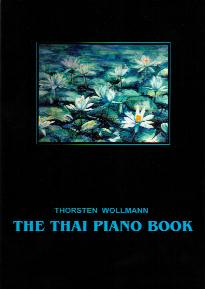Premiere performances: PRELUDES I-IV in June 97 and MEDITATIONS I-III in
December 97 in Chiang Mai by the composer. First German performance of PRELUDES
I-III in November 97 in Cologne. PRELUDES I-IV, IX-XII and FLOWERS I-III in
Biberach, September 98 by the composer.
Composers ranging from Bach, Chopin, Debussy, Scriabin and Shostakovich and
on up to the contemporary composers have written piano preludes, mostly as
collections of 24 pieces, in all major and minor keys. Because I appreciate the
form of the prelude very much and have always liked to play this kind of piano
pieces by different composers, I have planned for a long time to compose my own
collection of preludes.
Because I do not think in tonalities, but rather in color-sound-relations, I
did not want to use the traditional, often approved, 24-part-model. Also it was
not so important for me to organize a set of preludes only. Moreover I thought
that adding to or infiltrating pieces with another character could bring a
wishful contrast.
THE THAI PIANO BOOK consists of 25 single, short piano pieces, which are
built together like a symmetric fan. The Pythagorean form is based on the
mathematical formula: 3x3+4x4=5x5(=25). The set of sixteen preludes exists in
four groups of four pieces, while the other nine compositions are infiltrated in
three groups of three. Their structure can be divided also in seven blocks,
which are composed in a way that they could be performed singly, but this is not
the only possibility of a performance of single parts from the work.
Like the name already says, there is another relationship to the composition,
beyond those already mentioned, and this is even more important for me. All
single pieces were written in Thailand, my guest country and my second home.
Although, as an European I always think and act in the European way and also
write European music, my Asian environment in its totality has influenced and
inspired me emotionally and visually, which has affected the whole creation of
the THAI PIANO BOOK. The atmospheres, which I here tried to capture and
transform into notes, are only to be found in this country. An attempt for the
same composition would have gone differently on European soil.
In my earlier jazz composition “SIAM”, a three part suite for my own Jazz
Quintet, I expressed my preference for this country through the three
dedications: “…to the Rivers”, “…to the Lord Buddha” and “…to
the People of Siam,” which were at the same time the titles of the movements.
I took these ideas again for the THAI PIANO BOOK, to create in a similar way the
characteristics of different pieces between the Preludes. MEDITATIONS, FLOWERS,
and DANCES stand for the spirit, the nature and the humans. The group of the
dances is even more divided into three parts: much the same as in some Thai
epics, for example the Thai Ramayana, which tells about humans, gods and demons.
Memorable it is, that the three flowers, which are the only pieces with precise
describing subtitles, fill the very middle of the form. The lotus flower, which
means something very special in Thailand, stands exactly in the center.
The opening Prelude should, like an opening curtain, give a view inside a
world filled of colors. Prelude III is like the magic of spring. Meditation II
demands a quality piano, at best a grand piano, because the sounds should melt
together over the sustain pedal and they should be held on long in a very slow
tempo. Meditation III can be compared with some kind of a crystal-like tone.
Prelude V is fast and light like the wind. In Prelude VI one should be able to
hear the melody well. “Tropical Night” would be a subtitle for Prelude VIII,
which can be phrased in a very rhythmic and jazzy style. Flower I
“Helliconia” is like emerging from a dream. The most tender composition
“Lotus” must be played with a shimmering style. The clusters should float
like blossoms and leaves on the water. Orchids caught my attention especially
through their bizarre air roots and strangely formed blossom leaves. This
characteristic I have tried to express musically through chromatic scales. The
polyrhythmic Prelude IX lives from the accents inside the groups. Prelude X, I
like to call “balloon song”, because one should gain the impression of
moving in the air. It also recalls a little bit of a children’s song, and
there is a harmonic quote from “Theme for Janine”, which I wrote for my
daughter. The twelfth prelude consists of 25 bars, so it mirrors the form of the
whole work in itself. The “Village Dance” should be played very lively and
joyfully. “Dance of the Demons” is wild and sarcastic while I imagine in
“Dance of the Gods”, how the God appearances only move smoothly, as an over
earthen shimmer like. Prelude XIII is an etude and should be played determined
and energetic. Prelude XIV could suit a romantic movie scene, while Prelude XVI
is like a solemn procession in which one could imagine old Siam with kings and
elephants. Indeed, this next-to-the last prelude is the most majestic and
full-toned in the cycle. The last piece relates to the first and ends the whole
work with a fifths chord that stretches over the complete keyboard.
Mae Ta, Mai 16th 1998
back
